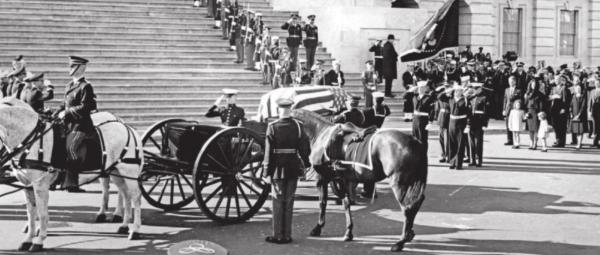Who was Black Jack and why should history remember him?
On Friday, November 23, 1963, I was sitting in civics class. The next week would be our two-day Thanksgiving vacation. Suddenly, the door burst open and a classmate, who had skipped class to attend the Presidential Parade in downtown Dallas, rushed in. Out of breath, in what she meant to be whispered tones, she blurted, “President Kennedy has been shot. So has Governor Connally. Both are at Parkland.”
The next passing period was eerily quiet. Reaching class, we all sat silently, hoping our teacher would know more. He, too, was quiet. Finally, the silence was broken by the voice of our principal, Mr. Stroud. He had no additional news, but said he was connecting the public address system to a local CBS radio station, where Walter Cronkite was reviewing events. Then came the news: Kennedy was dead.
We were excused for the day. It was a strange feeling, walking wordlessly to the parking lot. Then again, it was the first time in our lives a president had been assassinated.
At home, my family crowded around the black-and-white TV, watching coverage of our country in mourning. We also watched as Jack Ruby shot Kennedy’s assassin early Sunday morning.
On Monday, November 25th, more than 1 million Americans lined the funeral procession’s route, from the capitol, back to the White House, to St. Matthew’s Cathedral and, finally, to Arlington National Cemetery. Millions more, across the U.S. and in 23 countries (via satellite), watched the cortege.
That’s when the world met Black Jack for the first time, the sleek, coalblack Morgan-American Quarter Horse, in the Caisson Platoon of the 3rd U.S. Infantry Regiment (The Old Guard). Named in honor of Gen. John J. "Black Jack" Pershing, he was the riderless horse in JFK’s cortege and later, in more than 1,000 Armed Forces Full Honors Funerals (AFFHF). With boots reversed in the stirrups, Black Jack was a symbol of a fallen leader.
Black Jack was foaled January 19, 1947. On November 22, 1952, he came to Fort Myer from the cavalry remount station at Fort Reno, Oklahoma. Black Jack was the last of the Quartermaster–issue horses branded with the Army's U.S. brand (on the left shoulder) and his Army serial number 2V56 (on the left side of his neck).
Despite his refusal to be mounted and an ornery attitude, Black Jack won hearts with his good looks – his beautiful head with the small, white star marking, his muscled build and glistening black coat.
When Fort Reno’s administration refused to sell the horse and the Army needed horses for the Caisson Platoon at Fort Myer (Va.), Black Jack was transferred. No one knew the black gelding would make such a contribution to his country.
Black Jack began serving in the Caisson Platoon of the 3rd U.S. Infantry Regiment (The Old Guard), participating in an average of six funerals per day.
On the day of Kennedy’s funeral, Black Jack’s 19-yearold handler Arthur Carlson gave this account to author Thomas Reid in a 2008 interview: “At the White House, instead of standing steady, Black Jack constantly threw his head and danced around me. After about 10 seconds, people stopped crowding us and gave us space. We carried the president’s body from the White House to the Capitol. Then we moved out and walked back to the stable.
“When we got there, the men taking care of the other horses said all the TV people had talked constantly about Black Jack and the soldier with him.
“After the president had been in state, we went back to the Capitol. Black Jack continued to act up. We moved the casket to Saint Matthew’s Cathedral for the funeral service, and at the cathedral, people again began crowding Black Jack and me.
“I tried to stand at parade rest, holding his bridle. At one point he was pawing the pavement and struck my right shoe. I was afraid my toes might be broken. There were no fractures but the shoe was ruined.
“After the ceremonies, back at the stables, the telephone rang. Jackie Kennedy was requesting the tack – the gear Black Jack wore that day – be delivered to the White House.
“I put on a clean uniform, borrowed some shoes and gathered up the tack, cleaned but not polished, and a car came to pick me up,” Carlson said. “Arriving at the White House, the lights had been dimmed and the mood somber.”
The TV coverage of Kennedy’s funeral brought school busloads of children to Fort Myer after their parents and teachers realized Black Jack was a national treasure. The horse seemed to love the children.
Black Jack retired on June 1, 1973.
As the horse aged, he developed arthritis and other problems. After marching on black top for the majority of his life, he began to experience issues with his front feet. His overall health deteriorated rapidly.
Black Jack died after 29 years of military service on Feb. 6, 1976, and was laid to rest at Fort Myer with full military honors, at that time only the second horse in U.S. history to receive such honors.
Black Jack’s story is fading with the years, but his place in history is worth remembering.
Resources: Various newspaper reports, Wikipedia, AL.com, “Black Jack: America’s Famous Riderless Horse” by Robert Knuckle (2002) and the columnist’s personal rememberings.


